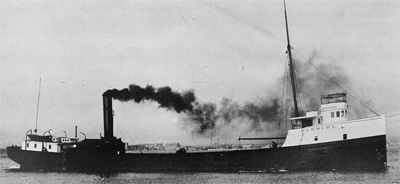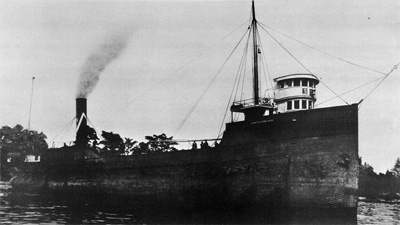Table of Contents
Each month, we do a good bit of searching to come up with an interesting "Ship of the Month" for our readers, our inspiration coming from widely varying sources. Seldom, however, is our feature article inspired by a photograph as it is this month. A short while ago, Al Sagon-King of Thorold came up with a fine photo of the old wooden steamer SENATOR DERBYSHIRE, the view having been taken by his father many years ago. We sat down to take a good look at the intriguing shot and were so fascinated by it that we decided to take a crack at SENATOR DERBYSHIRE for the January "Ship of the Month". What follows is the result; we hope that it will lead off a series of interesting features to come your way through these pages during 1979.
To set the stage for the entrance of our featured steamer, we must go back in time to the last decade of the nineteenth century, when wooden freighters were still being built for lake trade even though it was evident that the steel hull was here to stay. Prior to the turn of the century, there were, of course, many more shipbuilding yards situated around the lakes than there are now. One of the most famous builders of wooden ships was James Davidson of West Bay City, Michigan, who was also a prominent vessel owner and operator. Davidson's daughter Laura married George Ashley Tomlinson who was to become, in his own right, one of the lakes' most respected operators of steamboats.
James Davidson managed a large fleet of wooden steamers and schooner barges, most of which had been built in his own yard. The Davidson Steamship Company was a thriving concern and seldom did a year pass without a new hull being added to the fleet. The 1897 season saw the construction of a new wooden hull which measured 220 feet in length, 40.8 feet in the beam, and 16.8 feet in depth, these dimensions giving her a Gross Tonnage of 1312 and Net Tonnage of 1079. She was powered by a steeple compound engine with cylinders of 21 and 42 inches and a stroke of 30 inches. The machinery was built by the Vulcan Iron Works of Chicago.
The new steamer was enrolled at Duluth as U.S.3729 and was christened BERMUDA. The majority of Davidson's boats were given exotic place names, some of them honouring locations in the Caribbean or Central or South America. Needless to say, BERMUDA never managed to make her way to the island for which she was named.

James Davidson's BERMUDA is downbound in the lower harbour at Sault Ste. Marie in this Young photo dated 1908.
BERMUDA was, in many ways, a typical product of the Davidson shipyard which was acknowledged to be one of the most accomplished at building wooden lakers and was, in fact, one of the last to build this type of vessel. She had a raised forecastle on which was mounted a small rounded pilothouse located forward of a texas cabin which contained the master's accommodation. On the monkey's island, in the fashion of the day, was an open bridge from which most if not all of the navigation was done. We must remember that it was once considered to be a part of an officer's duty to be out in the open, exposed to all the inclemency that the elements could throw at him; if the only way to stay warm whilst on watch was to stand up to the waist in a barrel of straw, then that was what was expected.
If the forward end of BERMUDA was rather handsome, her after end was somewhat less so. A flush quarterdeck was surmounted by a small cabin, forward of which was an even smaller iron boilerhouse out of which sprouted a rather thin black stack. Like most Davidson boats, but unlike the majority of wooden lake steamers, BERMUDA sported an elliptical stern with considerable overhang. It curved in a continuous arc outwards and upwards from the rudder post to the taffrail instead of halting at various angles and corners. Almost all of the accommodations were located in the forecastle, a dark and dreary space totally devoid of portholes or windows except in its after bulkhead. The forecastle and cabin structures were painted white, the hull and boilerhouse black.
James Davidson operated BERMUDA in his own service for more than a decade and in 1908 she was given an extensive refurbishing and rebuilding. It was not uncommon for wooden lake freighters to require such treatment at relatively frequent intervals, for their oak hulls could take only so much of the wear and tear to which they were subjected. We believe that it was at this time that BERMUDA was given the rather flimsy mainmast that she sported until the end of her days. Needless to say, it did nothing whatever for her appearance.
The day of the big wooden bulk carrier was, however, drawing to a close at this time and such boats could no longer pay their way in the major lake trades. Most of them were either retired, sold off the lakes, or else purchased by owners who could put them to use carrying such undistinguished cargoes as coal and lumber. BERMUDA was no exception and, on February 6, 1909, she was sold by Davidson to one H. A. Clark of Brockville, Ontario. At the time of the sale, it was announced that she would not immediately be transferred to Canadian registry, but later in 1909 she was enrolled at Montreal as C.112351 and was registered to Antoine Wendling of Brockville. Her tonnage was computed by Canadian methods as 1246 Gross and 987 Net. It was during 1910 that the steamer was renamed (b) SENATOR DERBYSHIRE.
Not much is known about the shipping operations of Antoine Wendling or, for that matter, of H. A. Clark, but the former gentleman remained her owner of record until January 14, 1914, when she was purchased by Captain Alban Robineau of Montreal. (This spelling of the Captain's name is taken from the 1914 List of Shipping but certain other sources have spelled his name "Robideau".) The year 1915 saw her ownership passed to Wilson, Paterson and Company, Montreal, and it is to be presumed that this firm employed her in the coal trade as, probably, did both Robineau and Wendling previously.
In 1917, SENATOR DERBYSHIRE was operated under charter to the Canada Shipping Company, Montreal, an enterprise of the famous Frank A. Augsbury. When Augsbury formed the George Hall Coal Company of Canada Ltd., Montreal, in 1918, the DERBYSHIRE was purchased by the new concern. In fact, the sale took place on January 1st, 1918. The steamer was employed basically in the coal trade by Hall but it is likely that, from time to time, she was sent to the lower St. Lawrence River in order to fetch a load of pulpwood.
The Hall interests have never been averse to corporate reorganizations and their shipping history is regularly punctuated by such events. One such reorganization took place in 1922, at which time SENATOR DERBYSHIRE was transferred to the George Hall Coal and Shipping Company Ltd., Montreal. On Monday, August 14th of the same year, she managed to find herself stranded on Gooseneck Island, a predicament from which she was released on August 16. She suffered little damage in the accident.

The date is c.1922 as SENATOR DERBYSHIRE is upbound in the Welland Canal. Photo by Henry F. Sagon-King of St. Catharines and courtesy of A. F. Sagon-King.
SENATOR DERBYSHIRE managed to get herself in trouble again early the following year. On May 22, 1923, she was involved in a collision on Lake St. Francis in the St. Lawrence River. Strangely enough, the other boat involved was Hall's steel canaller LUCIUS W. ROBINSON. Neither steamer was seriously damaged and SENATOR DERBYSHIRE was able to continue in the coal trade for the remainder of the 1923 navigation season.
By the mid-1920s, however, the day of the steel canaller had definitely arrived. Many Canadian fleets were taking advantage of the chance to obtain one or more of the canal steamers which were being turned out in large numbers by shipyards in Canada and Great Britain. The Hall fleet was no exception and many of the new canallers either had been added to the company's roster or else were on order and would be commissioned in the near future. None too reluctantly, Hall and other operators sought to dispose of their wooden tonnage which had been rendered obsolete. SENATOR DERBYSHIRE had spent a good many years carrying coal from various Lake Ontario ports to Montreal and bringing pulpwood from the lower St. Lawrence to paper mills located in the vicinity of Ogdensburg, but her day was drawing to a close.
Before Hall had a chance to retire SENATOR DERBYSHIRE and relegate her to the ignominy of spending her declining years in the backwater of some boneyard, the ship herself took care of the problem. On Saturday, October 11, 1924, SENATOR DERBYSHIRE was upbound light on Lake Ontario, en route to pick up another coal cargo for Montreal. She had passed Main Duck Island and was in a position to the east of Point Petre Light (which marks the southwestern extremity of Ontario's Prince Edward County) when it was found that the steamer was afire. The crew abandoned ship and all were safely rescued by the Tree Line package freighter MAPLEBAY which, fortunately, was in the vicinity when the fire was discovered. There was no help for SENATOR DERBYSHIRE herself, however, and the fire raged in the wooden hull until it reached the waterline, whereupon the remains of the vessel sank. The ship was valued at approximately $25,000 at the time of her loss.
SENATOR DERBYSHIRE would not long have remained in service even if the fire had not intervened. All things considered, however, she did have an active life in excess of 25 years' duration and accordingly had done rather well for a ship of her type. Her longevity was a tribute to the craftsmen who had made the Davidson shipyard at West Bay City a force with which to be reckoned in the days of wooden ship construction.
(Ed. Note: An invaluable source of information for this history is The Wishbone Fleet by member Daniel C. McCormick.)
Previous Next
Return to Home Port or Toronto Marine Historical Society's Scanner
Reproduced for the Web with the permission of the Toronto Marine Historical Society.